Geochemistry and Geometrical Features of the Upper Cretaceous Vitulano Para-Autochthonous Karst Bauxites (Campania Region, Southern Italy): Constraints on Genesis and Deposition
Abstract
:1. Introduction
2. Geological Framework
3. Sampling and Analytical Methods
4. Results
4.1. Texture, Mineralogy, and Geometric Parameters
4.2. Geochemistry
5. Discussion
5.1. Image Analysis in Bauxites
5.2. Genesis of Vitulano Bauxites
6. Conclusions
- i.
- In the environs of the town of Vitulano, several small bauxite bodies have been found. appearing as filling of small depressions and karst cavities on which minero-chemical and petrographic assessments were performed together with image analysis assessment.
- ii.
- The petrographic analysis revealed that the texture of the studied bauxites consists of sub-circular aggregates (ooids) dispersed in a fine Ca-rich matrix.
- iii.
- The mineralogy of aggregates mainly consists of boehmite and Al-hematite, reflecting different climate conditions that occurred during their formation since boehmite formed in a dry climate, while Al-hematite formed during more humid periods.
- iv.
- The chemical composition of Vitulano bauxites is dominated by Al2O3 and CaO and subordinately by Fe2O3 and SiO2.
- v.
- Tectonic activity has controlled the formation and deposition of the studied bauxites, which are para-autochthonous, as demonstrated by their textural and compositional features, deriving through erosion, transport, and the re-deposition of pre-existing bauxitic deposits.
- vi.
- Textural and parental affinity geochemical indices, together with image analysis parameters, indicate that the original deposits that formed the Vitulano bauxites most likely were exposed in the Matese Mts. and the Caserta district areas which are located close to the studied bauxites.
Author Contributions
Funding
Institutional Review Board Statement
Informed Consent Statement
Data Availability Statement
Acknowledgments
Conflicts of Interest
References
- Bárdossy, G. Karst Bauxites: Bauxite Deposits on Carbonate Rocks; Elsevier: Amsterdam, The Netherlands, 1982. [Google Scholar]
- D’Argenio, B.; Mindszenty, A. Bauxites and related paleokarst: Tectonic and climatic event markers at regional unconformities. Eclogae Geol. Helv. 1995, 88, 453–499. [Google Scholar]
- Price, G.D.; Valdes, P.J.; Sellwood, B.W. Prediction of modern bauxite occurrence: Implications for climate reconstruction. Palaeogeogr. Palaeoclimatol. Palaeoecol. 1997, 131, 1–13. [Google Scholar] [CrossRef]
- Bárdossy, G.; Combes, P.J. Karst Bauxites: Interfingering of Deposition and Palaeoweathering. In Palaeoweathering, Palaeosurfaces and Related Continental Deposits; Thiry, M., Simon-Coinçon, R., Eds.; Blackwell Publishing Ltd.: Oxford, UK, 1999; pp. 189–206. [Google Scholar]
- Mongelli, G.; Buccione, R.; Gueguen, E.; Langone, A.; Sinisi, R. Geochemistry of the Apulian allochthonous karst bauxite, Southern Italy: Distribution of critical elements and constraints on Late Cretaceous Peri-Tethyan palaeogeography. Ore Geol. Rev. 2016, 77, 246–259. [Google Scholar] [CrossRef]
- Abedini, A.; Mongelli, G.; Khosravi, M.; Sinisi, R. Geochemistry and secular trends in the middle–late Permian karst bauxite deposits, northwestern Iran. Ore Geol. Rev. 2020, 124, 103660. [Google Scholar] [CrossRef]
- Mongelli, G.; Boni, M.; Oggiano, G.; Mameli, P.; Sinisi, R.; Buccione, R.; Mondillo, N. Critical metals distribution in Tethyan karst bauxite: The cretaceous Italian ores. Ore Geol. Rev. 2017, 86, 526–536. [Google Scholar] [CrossRef]
- Mongelli, G.; Mameli, P.; Sinisi, R.; Buccione, R.; Oggiano, G. REEs and other critical raw materials in Cretaceous Mediterranean-type bauxite: The case of the Sardinian ore (Italy). Ore Geol. Rev. 2021, 139, 104559. [Google Scholar] [CrossRef]
- Young, G.M.; Nesbitt, H.W. Processes controlling the distribution of Ti and Al in weathering profiles, siliciclastic sediments and sedimentary rocks. J. Sediment. Res. 1998, 68, 448–455. [Google Scholar] [CrossRef]
- MacLean, W.; Bonavia, F.; Sanna, G. Argillite debris converted to bauxite during karst weathering: Evidence from immobile element geochemistry at the Olmedo Deposit, Sardinia. Miner. Depos. 1997, 32, 607–616. [Google Scholar] [CrossRef]
- Mongelli, G.; Boni, M.; Buccione, R.; Sinisi, R. Geochemistry of the Apulian karst bauxites (southern Italy): Chemical fractionation and parental affinities. Ore Geol. Rev. 2014, 63, 9–21. [Google Scholar] [CrossRef]
- Abedini, A.; Calagari, A.A. REE geochemical characteristics of titanium-rich bauxites: The Permian Kanigorgeh horizon, NW Iran. Turk. J. Earth Sci. 2014, 23, 513–532. [Google Scholar] [CrossRef]
- Abedini, A.; Mongelli, G.; Khosravi, M. Geochemical constraints on the middle Triassic Kani Zarrineh karst bauxite deposit, Irano–Himalayan belt, NW Iran: Implications for elemental fractionation and parental affinity. Ore Geol. Rev. 2021, 133, 104099. [Google Scholar] [CrossRef]
- Ahmadnejad, F.; Zamanian, H.; Taghipour, B.; Zarasvandi, A.; Buccione, R.; Ellahi, S.S. Mineralogical and geochemical evolution of the Bidgol bauxite deposit, Zagros Mountain Belt, Iran: Implications for ore genesis, rare earth elements fractionation and parental affinity. Ore Geol. Rev. 2017, 86, 755–783. [Google Scholar] [CrossRef]
- Khosravi, M.; Abedini, A.; Alipour, S.; Mongelli, G. The Darzi-Vali bauxite deposit, West-Azarbaidjan Province, Iran: Critical metals distribution and parental affinities. J. Afr. Earth Sci. 2017, 129, 960–972. [Google Scholar] [CrossRef]
- Weng, S.; Yu, W.; Algeo, T.J.; Du, Y.; Li, P.; Lei, Z.; Zhao, S. Giant bauxite deposits of South China: Multistage formation linked to Late Paleozoic Ice Age (LPIA) eustatic fluctuations. Ore Geol. Rev. 2019, 104, 1–13. [Google Scholar] [CrossRef]
- Mameli, P.; Mongelli, G.; Sinisi, R.; Oggiano, G. Weathering Products of a Dismantled Variscan Basement. Minero-Chemical Proxies to Insight on Cretaceous Palaeogeography and Late Neogene Palaeoclimate of Sardinia (Italy). Front. Earth Sci. 2020, 8, 290. [Google Scholar] [CrossRef]
- Yu, W.; Oggiano, G.; Mongelli, G.; Zhou, J.; Buccione, R.; Xu, L.; Mameli, P.; Du, Y. U-Pb detrital zircon ages and Hf isotope from Sardinia and Adria Cretaceous bauxite (Italy): Constraints on the Alpine Tethys paleogeography and tectonic evolution. Ore Geol. Rev. 2023, 153, 105272. [Google Scholar] [CrossRef]
- Bogatyrev, B.; Zhukov, V. Bauxite provinces of the world. Geol. Ore Depos. 2009, 51, 339–355. [Google Scholar] [CrossRef]
- Mindszenty, A.; D’Argenio, B.; Aiello, G. Lithospheric bulges recorded by regional unconformities. The case of mesozoic-tertiary apulia. Tectonophysics 1995, 252, 137–161. [Google Scholar] [CrossRef]
- Combes, P.J.; Bárdossy, G. Geodynamics of Bauxites in the Tethyan Realm. In The Tethys Ocean; Nairn, A.E.M., Ricou, L.-E., Vrielynck, B., Dercourt, J., Eds.; Springer: Boston, MA, USA, 1996; pp. 347–365. [Google Scholar]
- Mongelli, G.; Buccione, R.; Sinisi, R. Genesis of autochthonous and allochthonous Apulian karst bauxites (Southern Italy): Climate constraints. Sediment. Geol. 2015, 325, 168–176. [Google Scholar] [CrossRef]
- Mameli, P.; Mongelli, G.; Oggiano, G.; Dinelli, E. Geological, geochemical and mineralogical features of some bauxite deposits from Nurra (Western Sardinia, Italy): Insights on conditions of formation and parental affinity. Int. J. Earth Sci. 2007, 96, 887–902. [Google Scholar] [CrossRef]
- Buccione, R.; Mongelli, G.; Sinisi, R.; Boni, M. Relationship between geometric parameters and compositional data: A new approach to karst bauxites exploration. J. Geochem. Explor. 2016, 169, 192–201. [Google Scholar] [CrossRef]
- Sinisi, R. Mineralogical and Geochemical Features of Cretaceous Bauxite from San Giovanni Rotondo (Apulia, Southern Italy): A Provenance Tool. Minerals 2018, 8, 567. [Google Scholar] [CrossRef] [Green Version]
- Boni, M.; Reddy, S.M.; Mondillo, N.; Balassone, G.; Taylor, R. A distant magmatic source for Cretaceous karst bauxites of Southern Apennines (Italy), revealed through SHRIMP zircon age dating. Terra Nova 2012, 24, 326–332. [Google Scholar] [CrossRef]
- Vitale, S.; Ciarcia, S. Tectono-stratigraphic setting of the Campania region (southern Italy). J. Maps 2018, 14, 9–21. [Google Scholar] [CrossRef]
- Vitale, S.; Amore, F.O.; Ciarcia, S.; Fedele, L.; Grifa, C.; Prinzi, E.P.; Tavani, S.; Tramparulo, F.D. Structural, stratigraphic, and petrological clues for a Cretaceous-Paleogene abortive rift in the southern Adria domain (southern Apennines, Italy). Geol. J. 2018, 53, 660–681. [Google Scholar] [CrossRef]
- Vitale, S.; Ciarcia, S.; Tramparulo, F.D. Deformation and stratigraphic evolution of the Ligurian Accretionary Complex in the southern Apennines (Italy). J. Geodyn. 2013, 66, 120–133. [Google Scholar] [CrossRef]
- Vitale, S.; Ciarcia, S. Tectono-stratigraphic and kinematic evolution of the southern Apennines/Calabria-Peloritani Terrane system (Italy). Tectonophysics 2013, 583, 164–182. [Google Scholar] [CrossRef]
- Diamanti, R.; Camanni, G.; Natale, J.; Vitale, S. A gravitational origin for volcano-tectonic faults in the Campi Flegrei caldera (southern Italy) inferred from detailed field observations. J. Struct. Geol. 2022, 161, 104671. [Google Scholar] [CrossRef]
- Vitale, S.; Ciarcia, S. The dismembering of the Adria platforms following the Late Cretaceous-Eocene abortive rift: A review of the tectono-stratigraphic record in the southern Apennines. Int. Geol. Rev. 2022, 64, 2866–2889. [Google Scholar] [CrossRef]
- Allocca, F.; Calcaterra, D.; Calicchio, G.; Cappelletti, P.; Colella, A.; Langella, A.; Parente, M.; Vitale, S.; De Gennaro, M. I Marmi di Vitulano e Cautano. In Le Pietre Storiche della Campania—Dall’oblio alla Riscoperta; De Gennaro, M., Calcaterra, D., Langella, A., Eds.; Luciano Editore: Napoli, Italy, 2013; pp. 235–254. [Google Scholar]
- Evensen, M.N.; Hamilton, P.J.; O’Nions, R.K. Rare earth abundances in chondritic meteorites. Geochim. Cosmochim. Acta 1978, 42, 1199–1212. [Google Scholar] [CrossRef]
- Meakin, P.; Fowler, A. Diffusion-limited Aggregation in the Earth Sciences. In Fractals in Petroleum Geology and Earth Processes; Springer: New York, NY, USA, 1995; pp. 227–261. [Google Scholar]
- Meakin, P. Fractals aggregates in geophysics. Rev. Geophys. 1991, 29, 317–354. [Google Scholar] [CrossRef]
- Chan, M.A.; Beitler, B.; Parry, W.T.; Ormö, J.; Komatsu, G. A possible terrestrial analogue for hematite concretions on Mars. Nature 2004, 429, 731–734. [Google Scholar] [CrossRef] [PubMed]
- Chan, M.A.; Ormö, J.; Park, A.J.; Stich, M.; Souza-Egipsy, V.; Komatsu, G. Models of iron oxide concretion formation: Field, numerical, and laboratory comparisons. Geofluids 2007, 7, 356–368. [Google Scholar] [CrossRef]
- Chan, M.A.; Potter, S.L.; Bowen, B.B.; Petersen, E.U.; Parry, W.T.; Bowman, J.R.; Barge, L.; Seiler, W. Characteristics of terrestrial ferric oxide concretions and implications for Mars. In Sedimentary Geology of Mars; Grotzinger, J., Milliken, R., Eds.; SEPM Special Publication: Broken Arrow, OK, USA, 2012; Volume 102, pp. 253–270. [Google Scholar]
- Parry, W.T. Composition, nucleation, and growth of iron oxide concretions in the Jurassic Navajo Sandstone, Utah. Sediment. Geol. 2011, 233, 53–68. [Google Scholar] [CrossRef]
- Sefton-Nash, E.; Catling, D.C. Hematitic concretions at Meridiani Planum, Mars: Their growth timescale and possible relationship with iron sulfates. Earth Planet. Sci. Lett. 2008, 269, 366–376. [Google Scholar] [CrossRef]
- Tardy, Y.; Nahon, D.B. Geochemistry of laterites. Stability of Al-goethite, Al-hematite and Fe3 kaolinite in bauxites and ferricretes. An approach to the mechanism of concretion formation. Am. J. Sci. 1985, 285, 865–903. [Google Scholar] [CrossRef]
- Crescenti, U.; Vighi, L. Risultati delle ricerche eseguite sulle formazioni bauxitiche cretaciche del Casertano e del Matese in Campania. Mem. Della Soc. Geolologica Ital. 1970, 9, 401–434. [Google Scholar]
- Bárdossy, G.; Boni, M.; Dall’Aglio, M.; D’Argenio, B.; Pantò, G. Bauxites of peninsular Italy. Composition, origin and geotectonic significance. Monogr. Ser. Miner. Depos. 1977, 15, 61. [Google Scholar]
- Carannante, G.; D’Argenio, B.; Ferreri, V.; Simone, L. Cretaceous paleokarst of the Campanian Appennines from early diagenetic to late filling stage. A case history. Rend. Della Soc. Geol. Ital. 1987, 9, 251–256. [Google Scholar]
- Condie, K.C. Chemical composition and evolution of the upper continental crust: Contrasting results from surface samples and shales. Chem. Geol. 1993, 104, 1–37. [Google Scholar] [CrossRef]
- Taylor, S.R.; McLennan, S.M. The Continental Crust: Its Composition and Evolution; Blackwell: Oxford, UK, 1985; pp. 1–312. [Google Scholar]

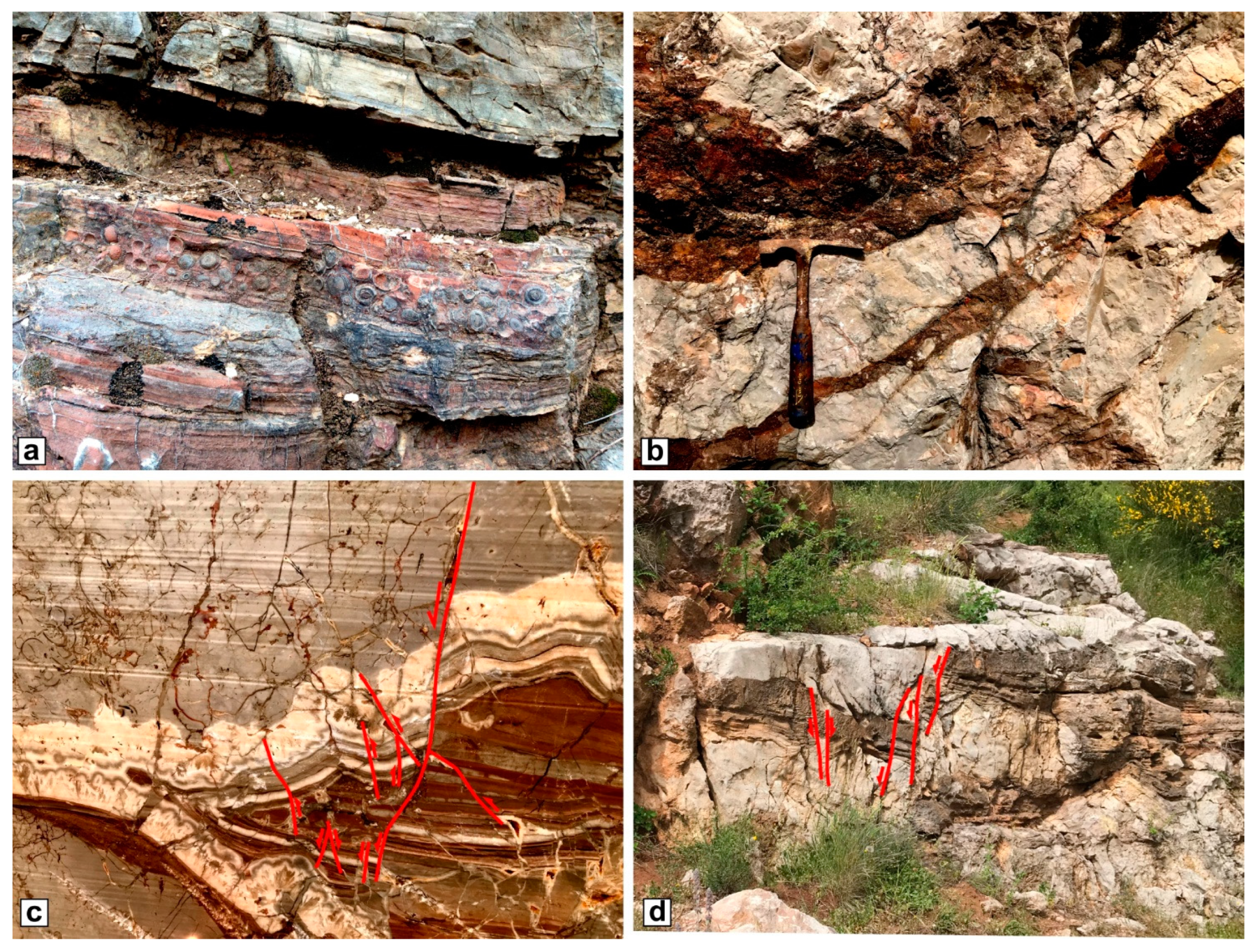
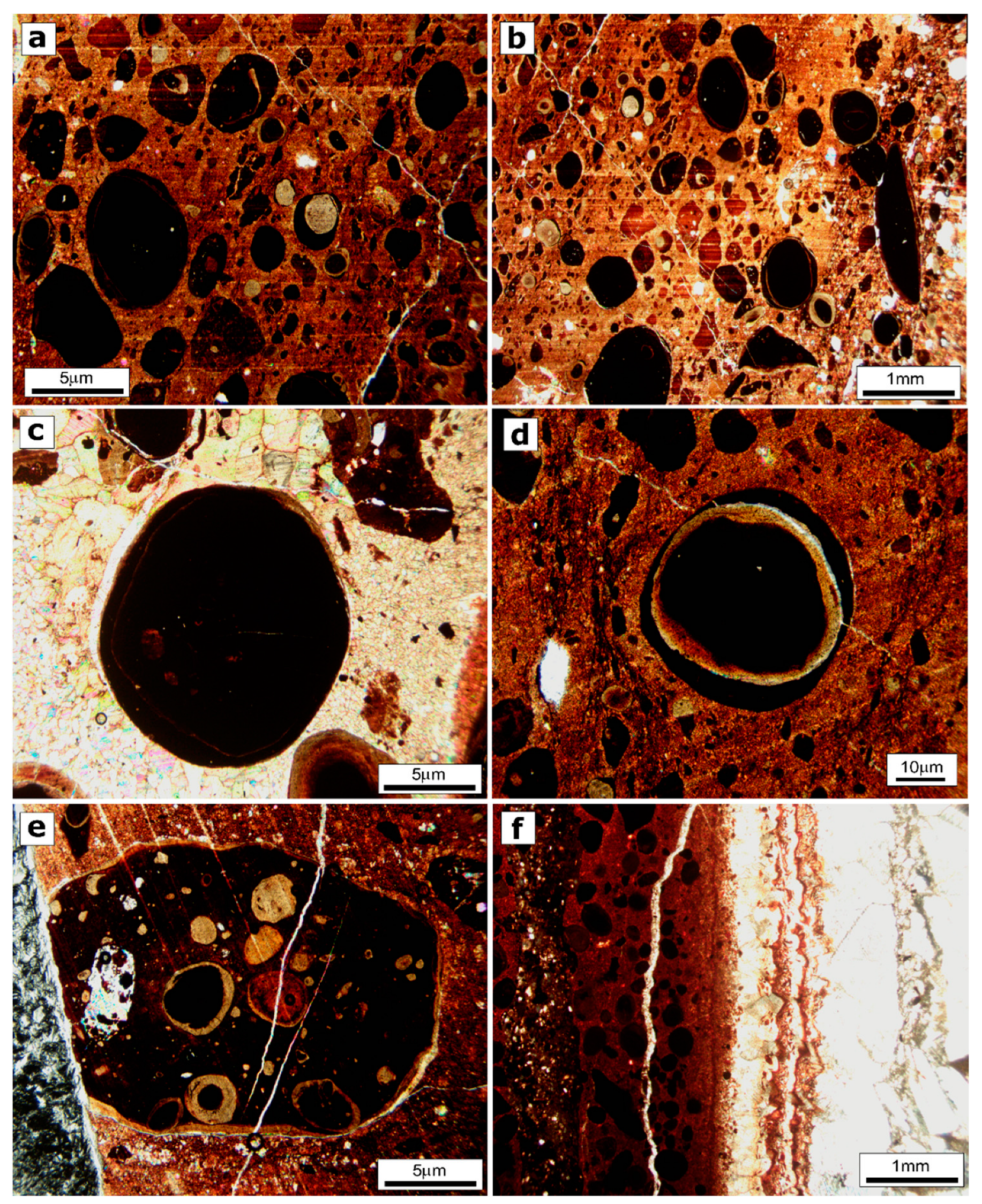
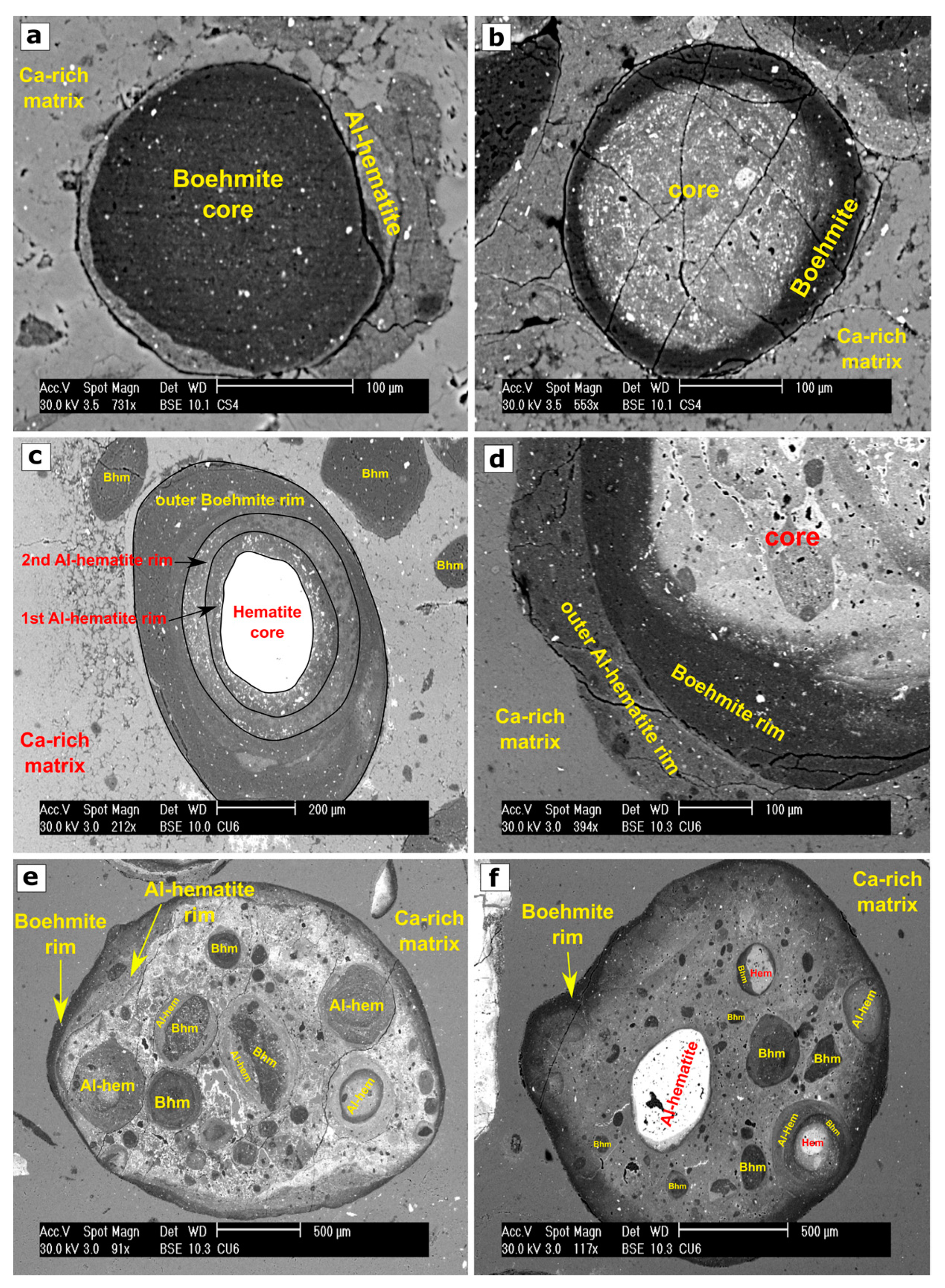
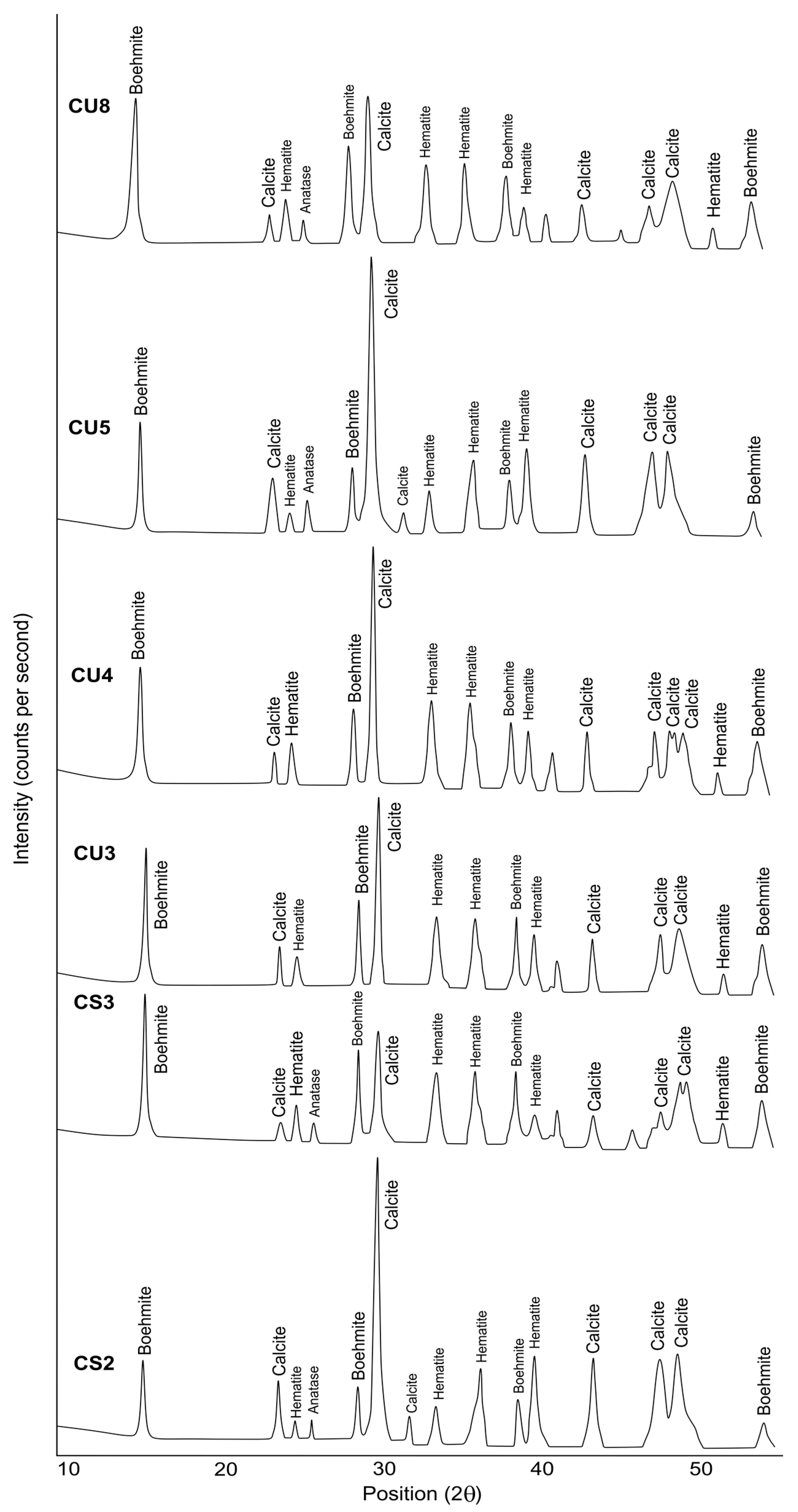

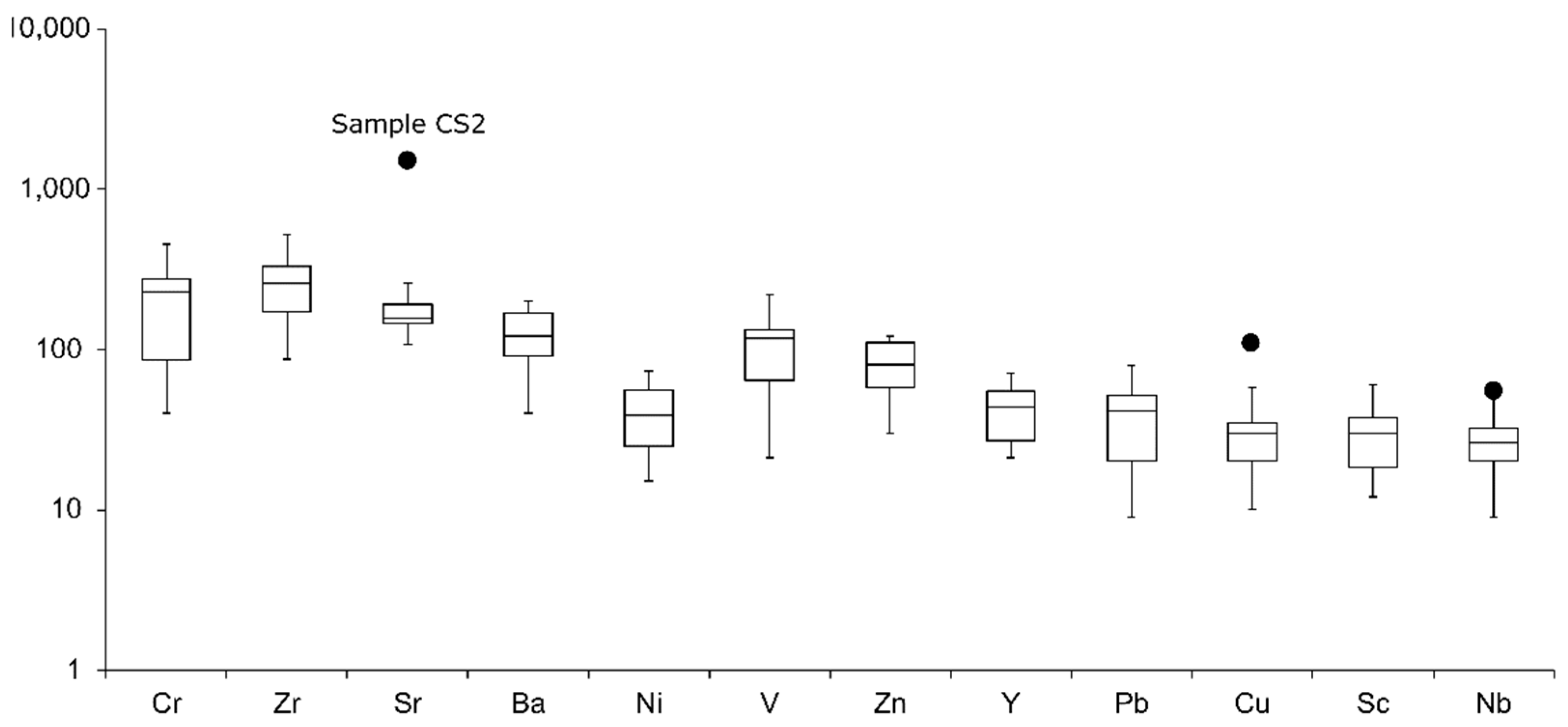
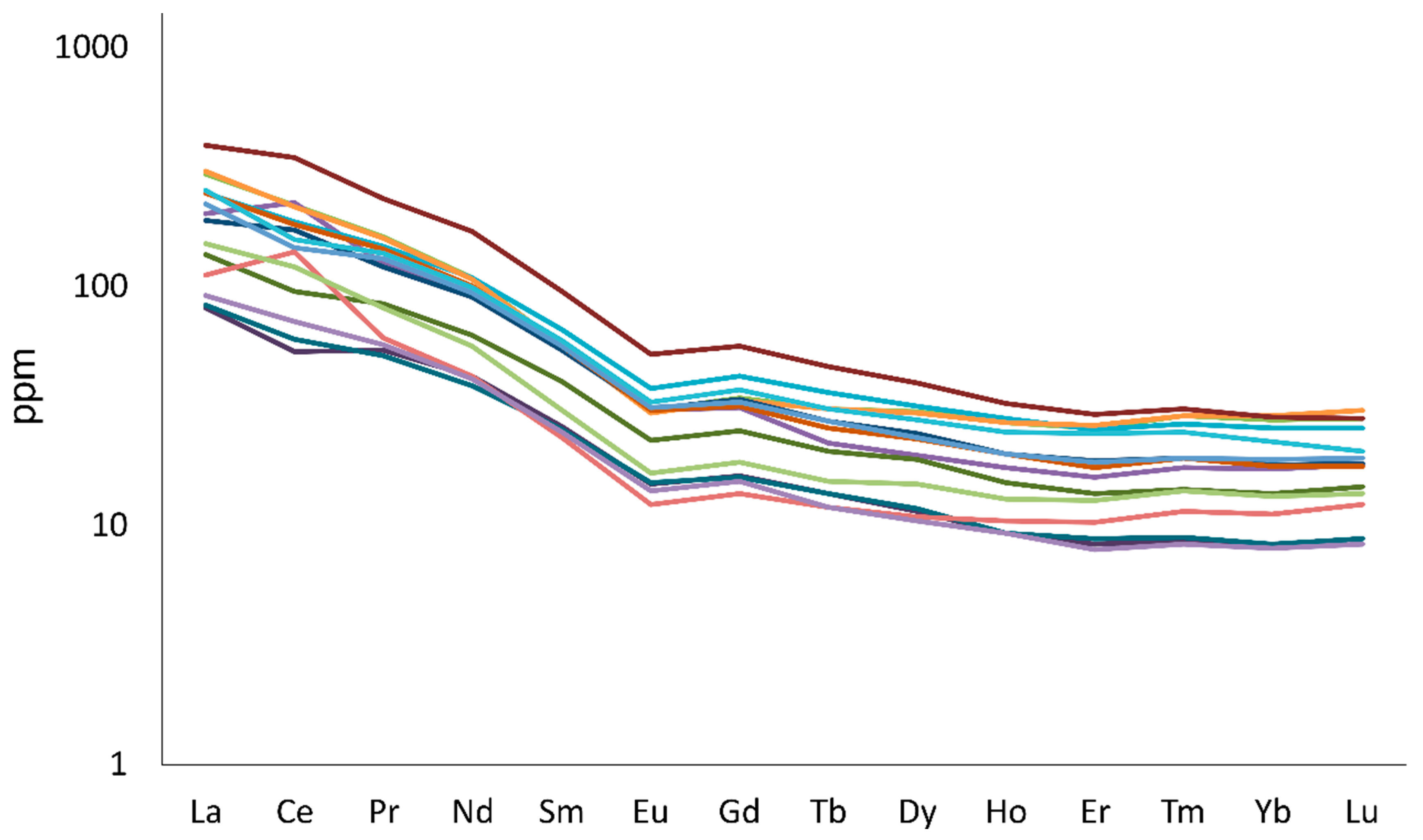
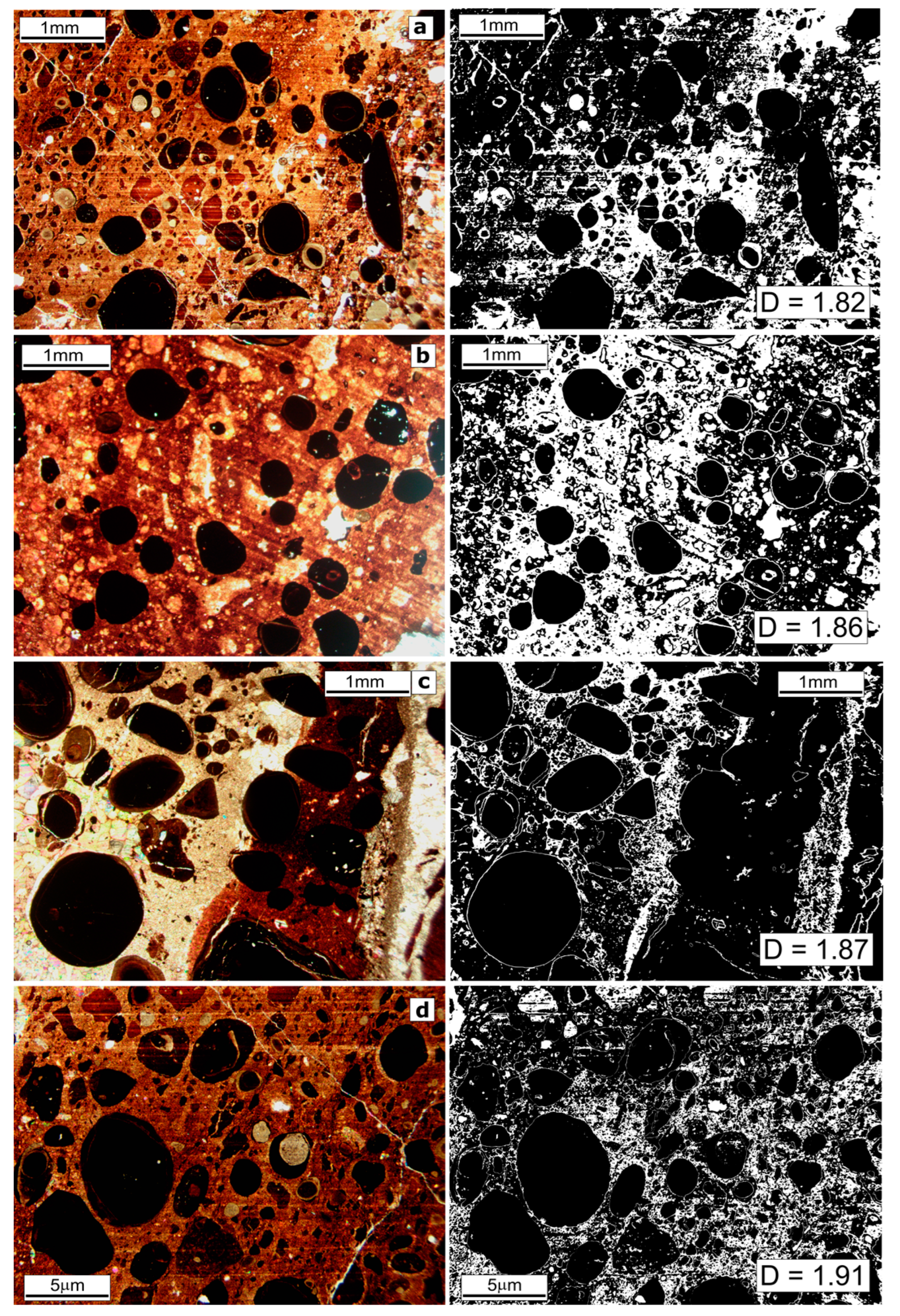


| Element wt. % | d.l. | CS1 | CS2 | CS3 | CS4 | CS5 | CS6 | CS7 | CU1 | CU2 | CU3 | CU4 | CU5 | CU6 | CU7 | CU8 |
|---|---|---|---|---|---|---|---|---|---|---|---|---|---|---|---|---|
| SiO2 | 0.01 | 7.51 | 7.07 | 5.28 | 6.03 | 5.67 | 4.36 | 6.53 | 3.89 | 9.05 | 3.76 | 5.24 | 6.65 | 4.65 | 3.84 | 4.47 |
| Al2O3 | 0.01 | 56.57 | 32.66 | 41.2 | 57.1 | 26.96 | 37.86 | 16.45 | 9.26 | 9.88 | 27.83 | 28.46 | 20.75 | 22.84 | 10.94 | 34.18 |
| Fe2O3 | 0.01 | 20.34 | 12.44 | 13.74 | 20.47 | 8.15 | 26.31 | 5.54 | 2.58 | 1.77 | 15.47 | 15.56 | 3.68 | 13.97 | 5.48 | 17.41 |
| MnO | 0.001 | 0.18 | 0.11 | 0.24 | 0.18 | 0.33 | 0.38 | 0.06 | 0.03 | 0.03 | 0.13 | 0.12 | 0.04 | 0.09 | 0.04 | 0.13 |
| MgO | 0.01 | 0.58 | 0.82 | 0.55 | 0.5 | 0.61 | 0.43 | 1.01 | 0.88 | 0.57 | 0.38 | 0.51 | 0.69 | 0.57 | 0.85 | 0.55 |
| CaO | 0.01 | 0.19 | 21.62 | 16.6 | 0.44 | 28.52 | 11.14 | 37.53 | 45.19 | 41.51 | 25.64 | 24.3 | 35.49 | 29.64 | 41.86 | 20.05 |
| Na2O | 0.01 | 0.03 | 0.03 | 0.02 | 0.02 | 0.02 | 0.01 | 0.03 | 0.02 | 0.02 | 0.01 | 0.01 | 0.02 | 0.01 | 0.02 | 0.03 |
| K2O | 0.01 | 0.29 | 0.39 | 0.14 | 0.23 | 0.19 | 0.11 | 0.39 | 0.19 | 0.22 | 0.08 | 0.19 | 0.23 | 0.11 | 0.17 | 0.09 |
| TiO2 | 0.001 | 2.54 | 1.50 | 1.79 | 2.64 | 1.23 | 1.76 | 0.77 | 0.47 | 0.45 | 1.25 | 1.36 | 1.08 | 1.07 | 0.52 | 1.65 |
| P2O5 | 0.01 | 0.1 | 0.28 | 0.61 | 0.08 | 0.28 | 0.1 | 0.09 | 0.1 | 0.17 | 0.06 | 0.08 | 0.13 | 0.06 | 0.08 | 0.05 |
| LOI | - | 12 | 23.28 | 20.23 | 11.96 | 26.58 | 17.13 | 31.45 | 36.54 | 34.84 | 25.09 | 24.14 | 31.02 | 27.77 | 34.75 | 21.32 |
| Total | 0.01 | 100.3 | 100.2 | 100.4 | 99.63 | 98.54 | 99.6 | 99.86 | 99.16 | 98.49 | 99.71 | 99.96 | 99.76 | 100.8 | 98.57 | 99.92 |
| ppm | ||||||||||||||||
| Sc | 1 | 40 | 30 | 38 | 41 | 26 | 60 | 21 | 12 | 16 | 37 | 35 | 14 | 25 | 14 | 37 |
| Be | 1 | 8 | 4 | 6 | 8 | 4 | 7 | 2 | 1 | <1 | 4 | 4 | 2 | 3 | 2 | 5 |
| V | 5 | 189 | 118 | 132 | 188 | 82 | 217 | 48 | 28 | 21 | 133 | 132 | 71 | 115 | 57 | 119 |
| Ba | 2 | 64 | 55 | 44 | 56 | 59 | 73 | 39 | 15 | 15 | 24 | 39 | 26 | 31 | 17 | 29 |
| Sr | 2 | 156 | 1520 | 164 | 145 | 198 | 238 | 184 | 166 | 133 | 149 | 107 | 291 | 114 | 147 | 157 |
| Y | 1 | 61 | 39 | 69 | 60 | 50 | 71 | 34 | 22 | 22 | 44 | 46 | 25 | 29 | 21 | 48 |
| Zr | 2 | 498 | 292 | 335 | 520 | 239 | 400 | 144 | 94 | 87 | 257 | 277 | 201 | 225 | 106 | 326 |
| Cr | 20 | 440 | 220 | 240 | 450 | 140 | 310 | 70 | 40 | 40 | 240 | 230 | 90 | 250 | 80 | 300 |
| Co | 1 | 35 | 22 | 43 | 34 | 31 | 49 | 6 | 1 | <1 | 19 | 15 | 9 | 14 | 5 | 22 |
| Ni | 20 | 200 | 120 | 190 | 200 | 150 | 200 | 140 | 40 | 40 | 110 | 110 | 80 | 100 | 50 | 150 |
| Cu | 10 | 40 | 30 | 30 | 40 | 30 | 40 | 10 | 20 | 20 | 30 | 30 | 20 | 20 | 10 | 110 |
| Zn | 30 | 110 | 80 | 110 | 120 | 80 | 110 | 40 | <30 | <30 | 60 | 80 | 50 | 60 | 30 | <30 |
| Ga | 1 | 58 | 33 | 41 | 61 | 26 | 41 | 17 | 9 | 7 | 28 | 30 | 20 | 24 | 11 | 38 |
| As | 5 | 30 | 26 | 17 | 32 | 11 | 36 | 11 | 5 | 41 | 17 | 17 | 8 | 21 | 14 | 27 |
| Rb | 2 | 17 | 16 | 6 | 13 | 8 | 5 | 15 | 7 | 8 | 4 | 10 | 9 | 6 | 8 | 6 |
| Nb | 1 | 50 | 31 | 26 | 53 | 24 | 36 | 17 | 9 | 10 | 26 | 28 | 23 | 23 | 11 | 34 |
| Mo | 2 | 4 | 4 | 7 | 5 | 5 | 6 | 2 | <2 | <2 | 3 | 2 | <2 | <2 | <2 | 3 |
| Sn | 1 | 10 | 6 | 5 | 10 | 4 | 8 | 3 | 1 | 2 | 5 | 6 | 4 | 5 | 2 | 7 |
| Sb | 0.5 | 7.5 | 6.2 | 5 | 7.6 | 3.3 | 7.2 | 2.5 | 2 | 1.7 | 10.4 | 9.7 | 4 | 9.5 | 4.6 | 8.5 |
| Cs | 0.5 | 3.8 | 4.2 | 2.2 | 3.8 | 2 | 1.9 | 3.6 | 1.5 | 1.2 | 1.5 | 2.6 | 2.7 | 2 | 1.9 | 1.8 |
| Hf | 0.2 | 12.5 | 7.7 | 3.2 | 13.8 | 6.4 | 10.9 | 3.8 | 2.3 | 2.4 | 7 | 7.3 | 5.3 | 6.2 | 2.9 | 9.4 |
| Ta | 0.1 | 1.5 | 0.9 | 0.3 | 0.9 | 0.8 | 1.1 | 1.1 | 0.6 | 0.6 | 1.2 | 1.4 | 1.2 | 1.3 | 0.7 | 2.4 |
| W | 1 | 8 | 7 | 7 | 6 | 7 | 4 | 5 | <1 | 1 | 10 | 6 | 3 | 3 | 3 | 6 |
| Tl | 0.1 | 0.3 | 0.2 | 0.2 | 0.3 | 0.3 | 0.2 | 0.1 | <0.1 | <0.1 | 0.1 | 0.3 | 0.1 | 0.2 | <0.1 | <0.1 |
| Pb | 5 | 64 | 41 | 41 | 68 | 26 | 79 | 20 | 9 | 20 | 51 | 35 | 12 | 42 | 18 | 53 |
| Th | 0.1 | 31.1 | 21.9 | 24.3 | 33.9 | 15.4 | 37.5 | 10.7 | 5.6 | 7.6 | 21.1 | 20.9 | 15.2 | 19.6 | 9.2 | 32.1 |
| U | 0.1 | 3.3 | 2.1 | 2.5 | 3.5 | 1.7 | 2.6 | 1.1 | 0.7 | 0.6 | 2.3 | 1.8 | 1.5 | 1.5 | 0.9 | 2.4 |
| La | 0.1 | 109 | 75.3 | 91.2 | 113 | 70.4 | 145 | 50.3 | 30 | 30.8 | 91.5 | 81.9 | 41.4 | 55.8 | 33.8 | 93.7 |
| Ce | 0.1 | 211 | 217 | 180 | 209 | 167 | 336 | 92.6 | 51.3 | 58.1 | 176 | 140 | 135 | 116 | 69.3 | 152 |
| Pr | 0.05 | 22.2 | 17.1 | 20.3 | 21.9 | 16.7 | 32.4 | 11.7 | 7.53 | 7.1 | 19.8 | 18 | 8.41 | 11.2 | 7.84 | 19.1 |
| Nd | 0.1 | 77.7 | 65.4 | 78.2 | 77.1 | 64.9 | 122 | 45 | 30.1 | 27.5 | 72.5 | 67.7 | 30.4 | 40.6 | 29.3 | 71 |
| Sm | 0.1 | 13.2 | 13 | 15.4 | 13.1 | 12.6 | 22.1 | 9.3 | 6 | 5.9 | 13.1 | 13.2 | 5.4 | 7.1 | 5.7 | 13.9 |
| Eu | 0.05 | 2.66 | 2.66 | 3.28 | 2.59 | 2.69 | 4.59 | 2 | 1.3 | 1.32 | 2.67 | 2.73 | 1.07 | 1.46 | 1.22 | 2.88 |
| Gd | 0.1 | 10.5 | 9.6 | 13 | 10.3 | 10.4 | 17.3 | 7.7 | 5 | 4.9 | 9.8 | 10.2 | 4.2 | 5.7 | 4.7 | 11.4 |
| Tb | 0.1 | 1.8 | 1.3 | 2.1 | 1.8 | 1.6 | 2.7 | 1.2 | 0.8 | 0.8 | 1.5 | 1.6 | 0.7 | 0.9 | 0.7 | 1.8 |
| Dy | 0.1 | 11.5 | 7.6 | 12.2 | 11.4 | 9.3 | 15.1 | 7.3 | 4.4 | 4.5 | 8.8 | 9 | 4.2 | 5.7 | 4 | 10.7 |
| Ho | 0.1 | 2.3 | 1.5 | 2.4 | 2.3 | 1.7 | 2.8 | 1.3 | 0.8 | 0.8 | 1.7 | 1.7 | 0.9 | 1.1 | 0.8 | 2.1 |
| Er | 0.1 | 6.4 | 4 | 6.3 | 6.6 | 4.7 | 7.3 | 3.4 | 2.1 | 2.2 | 4.4 | 4.6 | 2.6 | 3.2 | 2 | 6.1 |
| Tm | 0.05 | 1.03 | 0.63 | 0.95 | 1.04 | 0.69 | 1.11 | 0.51 | 0.31 | 0.32 | 0.69 | 0.69 | 0.41 | 0.5 | 0.3 | 0.88 |
| Yb | 0.1 | 6.9 | 4.3 | 6.4 | 7.2 | 4.5 | 7.1 | 3.4 | 2.1 | 2.1 | 4.4 | 4.7 | 2.8 | 3.3 | 2 | 5.6 |
| Lu | 0.01 | 1.08 | 0.69 | 0.98 | 1.16 | 0.7 | 1.08 | 0.56 | 0.34 | 0.34 | 0.68 | 0.74 | 0.47 | 0.52 | 0.32 | 0.79 |
| ƩREEs | 477.27 | 420.08 | 432.71 | 478.49 | 367.88 | 716.58 | 236.27 | 142.08 | 146.68 | 407.54 | 356.76 | 237.96 | 253.08 | 161.98 | 391.95 |
Disclaimer/Publisher’s Note: The statements, opinions and data contained in all publications are solely those of the individual author(s) and contributor(s) and not of MDPI and/or the editor(s). MDPI and/or the editor(s) disclaim responsibility for any injury to people or property resulting from any ideas, methods, instructions or products referred to in the content. |
© 2023 by the authors. Licensee MDPI, Basel, Switzerland. This article is an open access article distributed under the terms and conditions of the Creative Commons Attribution (CC BY) license (https://creativecommons.org/licenses/by/4.0/).
Share and Cite
Buccione, R.; Vitale, S.; Ciarcia, S.; Mongelli, G. Geochemistry and Geometrical Features of the Upper Cretaceous Vitulano Para-Autochthonous Karst Bauxites (Campania Region, Southern Italy): Constraints on Genesis and Deposition. Minerals 2023, 13, 386. https://doi.org/10.3390/min13030386
Buccione R, Vitale S, Ciarcia S, Mongelli G. Geochemistry and Geometrical Features of the Upper Cretaceous Vitulano Para-Autochthonous Karst Bauxites (Campania Region, Southern Italy): Constraints on Genesis and Deposition. Minerals. 2023; 13(3):386. https://doi.org/10.3390/min13030386
Chicago/Turabian StyleBuccione, Roberto, Stefano Vitale, Sabatino Ciarcia, and Giovanni Mongelli. 2023. "Geochemistry and Geometrical Features of the Upper Cretaceous Vitulano Para-Autochthonous Karst Bauxites (Campania Region, Southern Italy): Constraints on Genesis and Deposition" Minerals 13, no. 3: 386. https://doi.org/10.3390/min13030386






